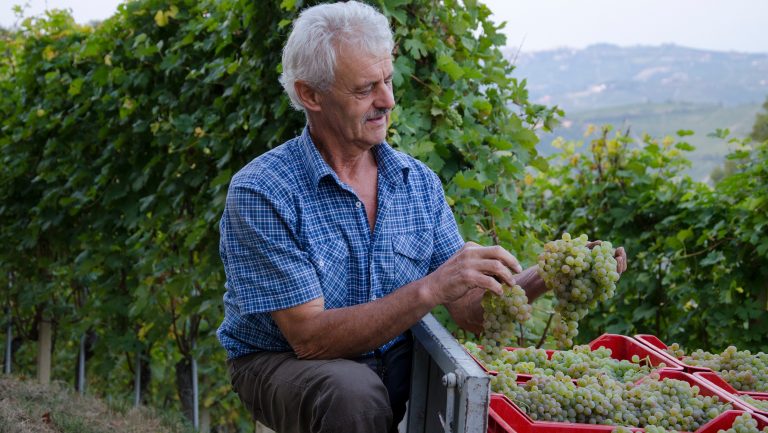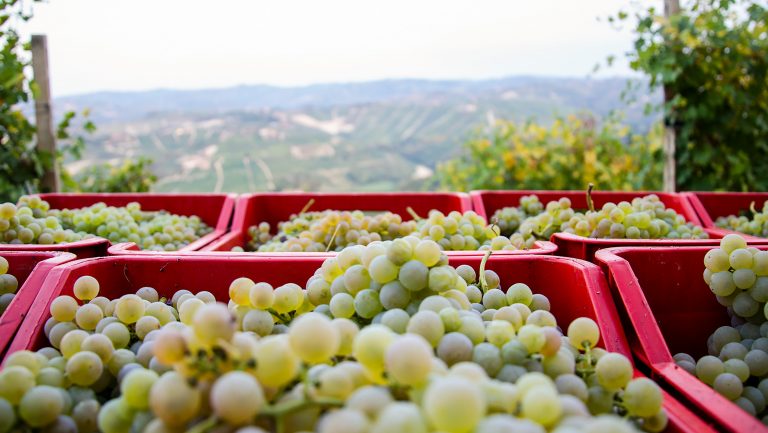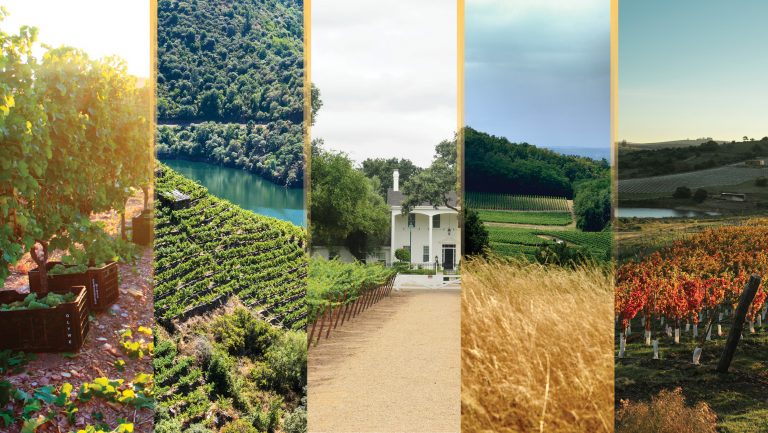On the outskirts of Monforte d’Alba, the Josetta Saffirio winery is located in the tiny hamlet of Castelletto, between the villages of Serralunga and Castiglione Falletto—in the middle of Barolo country. But what excites Sara Vezza, Josetta’s daughter and the fourth-generation proprietor of the estate, even more than Barolo is a rare white grape that grows in this area and practically nowhere else.
“We made our first Rossese Bianco in 2008,” says Vezza, “after a small vineyard of white grapes that had been leased out for a long time came back to us. My mother didn’t want to plant Chardonnay, and I’m glad she didn’t. The [Rossese] clusters are small and compact and the wine is unique. It’s moderately aromatic with scents of white flowers and petrol, mineral and sapid on the palate, and has lots of personality. When people come here to taste Barolo, many try Rossese first and are totally surprised. Everyone really likes it!”
Rossese Bianco probably came to this area centuries ago along the Via del Sale, the ancient trade route that connected coastal Liguria with landlocked Piedmont. Josetta Saffirio has a half hectare of Rossese, from which it produces about 3,000 bottles per year. The winemaker Giovanni Manzone, also in Castelletto, is another longtime supporter of Rossese Bianco, which was officially admitted to the Langhe DOC appellation in 2010. There are currently less than 2 hectares under vine and five wineries in the Langhe that produce it.

Don’t miss the latest drinks industry news and insights. Sign up for our award-winning newsletters and get insider intel, resources, and trends delivered to your inbox every week.
While the story of Rossese is distinctive, it’s not unusual: A few kilometers away in Novello, Valter Fissore of Elvio Cogno rescued the Nascetta grape from oblivion (it too was added to the Langhe DOC in 2010). In the nearby hills of Tortona, Walter Massa spearheaded a small group of producers in the early 1990s who championed a local grape called Timorasso, and decades earlier, Alfredo Currado of Vietti helped save Arneis in the Roero. There’s also Pelaverga, which can be found in Verduno, Ruché in Monferrato, and Erbaluce in Caluso. And this is just Piedmont—there are many other little-known grape varieties throughout the country, although exactly how many is unclear.
“Some experts estimate the number [of Italian grape varieties to be] as high as 2,000,” says Maurizio Broggi, the education director of the Wine Scholar Guild’s Italian Wine Scholar program. “The Italian National Registry of Grapes currently lists 545 [varieties]. If we consider only native wine grapes and exclude synonyms, the number is likely to be somewhere between 350 and 600, which is still far more than France, Spain, or Greece.”
“If you fall in love with Italy, you have a natural tendency to learn about obscure varieties,” says Bobby Stuckey, MS, the co-owner of Frasca Food & Wine, a Friuli-inspired restaurant in Boulder, Colorado. “When we opened in 2004, it was difficult to get diversity in the region we’re based on. Now, thanks to great independent importers and distributors, Colorado has lots of interesting Friulano wines you don’t see in many other places.”

Anthony Lynch, an importer at Kermit Lynch Wine Merchant in Berkeley, California, points out that today’s consumers are more open than ever to trying new grape varieties. “The weirder the better,” he says. “This sense of curiosity didn’t exist 15 to 20 years ago.” Shelley Lindgren, the co-owner and wine director of A16, a Bay Area pizzeria with a Southern Italian focus, agrees. “People are becoming more aware of the value and quality in Italian grapes, especially from lesser-known areas.”
But along with the excitement that comes with sharing wines made from obscure grapes, there are some potential pitfalls. “Sometimes,” laments Rob Mackin of Artisan Wines, an Italian-focused importer and distributor based in Norwalk, Connecticut, “an unknown wine like Pelaverga develops a steady following, but production is so limited we can’t get enough and regularly sell out. Other times, demand becomes so high that producers jack up the price, as happened with Timorasso.“
With steadily growing interest and hundreds of lesser known grapes, however, there’s always something new to discover. “Even after 20 years of being obsessed with obscure varieties,” says Ceri Smith, the founder of Biondivino Wine Boutique, which has locations in San Francisco and Palo Alto, “something new always pops up. That’s the beauty of Italy. Even islands off the islands have their own weird little beauties that people have made wine from for centuries.”
Here, from north to south, are some of the lesser-known Italian grapes that should be on every wine professional’s radar:
1. Timorasso (White; Piedmont)
This variety from the hills around Tortona in southeastern Piedmont produces medium- to full-bodied wines with a delicate floral-citrus aroma, solid tannic structure, and an excellent capacity to age. Frasca wine director Carlin Karr finds it “similar to a Chenin Blanc but with less earthiness.” She also points out that Timorasso is typically “high in acid with briny minerality and a beeswax textural component.”
2. Rossese (Red and White; Liguria and Piedmont)
Red Rossese is grown by a small group of producers in the hills above the village of Dolceacqua in western Liguria, where it benefits from salty sea breezes and notable shifts in diurnal temperatures. Mariarosa Tartaglione, the wine director at Ai Fiori in New York City, says the terroir gives the wine a “brilliant, translucent ruby red color, distinctive aromas of rosehips and black pepper spice, and flavors of wild raspberry and blackberry.”
The Rossese di Dolceacqua DOC contains 38 MGAs (menzioni geografiche aggiuntive, which are additional geographic indications). There is also a superiore version, which has a higher level of alcohol (13% ABV, as compared with 12%) and must age for at least one year. The Riviera Ligure di Ponente Rossese DOC is located a bit further east around the town of Albenga, and the wines here are much lighter in color and body, almost resembling a rosato.
Rossese Bianco is a genetically distinct variety from red Rossese and is even rarer in Liguria than it is in Piedmont, where it’s cultivated by producers such as Josetta Saffirio and Giovanni Manzone.

3. Schioppettino (Red; Friuli)
This is an ancient grape variety native to Friuli that is expressed especially well in the Colli Orientali area, around the town of Prepotto, near the Slovenian border. Somewhat tricky to grow, it almost disappeared after phylloxera hit the area and was actually banned until 1977, but plantings have been increasing over the last 10 years or so, as the wines have grown in popularity. Schioppettino yields wines that are typically dark in color with firm tannins, pronounced acidity, and moderate alcohol. Karr describes Schioppettino as “Northern Rhône Syrah meets Cru Beaujolais.” The wines, she says, are “peppery yet punchy.” She adds that Schioppettino “has aromatic intensity and length yet lightness on its feet.”
4. Friulano (White; Friuli)
Friulano (formerly known as Tocai Friulano), says Frasca’s Stuckey, is “a pillar of regional gastronomy that can take on many different faces. It can be crisp, light, and aromatic in the Friuli Grave, or big and powerful in the Colli Orientali.” While it can be—and often was—made as a simple, pleasant quaffing wine, wines made from well-sourced grapes with lower yields and attentive handling can age surprisingly well, developing tremendous complexity and intensity over time, along with a silky, almost oily texture.
5. Verdiso (White; Veneto)
This variety is the most prominent of the four “lost grapes,” now largely eclipsed by Glera, in the original Prosecco area. The intensely green berries with pronounced acidity and distinctive crab-apple astringency produce taut and edgy wines from the steep hills of Valdobbiadene, or rounder and grassier ones from the morainic soils of Conegliano. Scattered old vines throughout the area contribute zip and character to Prosecco, but the grape can definitely stand on its own if given the chance. “Today,” says Lynch, “only a handful of producers still cultivate Verdiso, but it deserves to make a comeback, as its naturally high acidity is a blessing in today’s warming climate.”

6. Piedirosso (Red; Campania)
Piedirosso is the ancient workhorse of Campania, and it turns up in many places on its own or in a blend—from the bubbly reds of Gragnano and Lettere on the Sorrentine Peninsula to the craters of Mount Vesuvius and Campi Flegrei. Because the vine thrives in volcanic soils where phylloxera can’t penetrate, old vines are not uncommon and many of them are ungrafted. “With soft tannins and delicate red fruit, ranging from cranberry and wild strawberry to cherry and fig, Piedirosso can soften the rough edges of Aglianico,” says A16’s Lindgren, “or stand all on its own.”
7. Fiano (White; Campania)
Along with Falanghina and Greco, Fiano is one of the most compelling white grapes of Campania. It displays a distinctive sinewy structure, exotic aromas of jasmine and linden flowers, and ripe pear flavors with additional notes of resin, honey, white balsamic vinegar, mandarin orange, and bitter almond on the finish. Fiano seems to express its fullest potential and character in the area of the Avellino DOCG, where it’s thought to have originated. While wines made from Fiano are enjoyable young and fresh, they can almost always benefit from time in bottle to develop and reveal their complexity. Ai Fiori’s Tartaglione explains that this variety is extremely versatile and expressive of its terroir. “In warmer coastal areas,” she says, “it shows more tropical floral notes, while in the high volcanic hills of Irpinia the wines are smoky, lean, and steely, with green apple and nectarine [flavors].”

8. Gaglioppo (Red; Calabria)
One of Italy’s oldest grape varieties, Gaglioppo is the red grape of Calabria, the region at the tip of the boot, where the ancient Greeks first landed and dubbed the area Oenotria because of the prevalence of grapevines. Though long eclipsed by overproduction of mediocre wines, the quality of Calabrian wine is on the upswing and Gaglioppo is leading the charge, especially under the Cirò DOC appellation. Medium- to full-bodied with moderate acidity, firm tannins, and notes of Mediterranean scrub, the wines, says Lindgren, present “a distinctive tomato-leaf and bergamot aroma, with savory sun-dried tomato, orange rind, and leather.”
9. Nerello Mascalese (Red; Sicily)
Closely connected with the area of Mount Etna, Nerello Mascalese is named after the town of Mascali, in the province of Catania. This variety is somewhat pale in color but moderately high in alcohol, with silky tannins, flinty minerality, and aromas of wild berries and herbs. “The wines display tremendous diversity according to producer, vineyard, and elevation,” says Biondivino’s Smith, “but a distinct energy and tension, along with that dusty volcanic soul, always shine through, balancing out the earthiness with fresh, brambly fruit.”
10. Carricante (White; Sicily)
This is another variety that’s practically exclusive to the area of Etna—and that’s currently enjoying a burst of popularity. Smith likens Carricante to a “beautiful Chablis” but suggests it has “a different accent and personality,” adding that it has “biting, bright acidity and laced-together structure, woven like a thick, silky net that keeps everything together.”

Dispatch
Sign up for our award-winning newsletter
Don’t miss the latest drinks industry news and insights—delivered to your inbox every week.
Alan Tardi has written about wine for many publications, including Wine & Spirits magazine, the New York Times, Food Arts, and Wine Spectator, and is the author of the James Beard Award–winning Romancing the Vine: Life, Love, and Transformation in the Vineyards of Barolo. His second book, Champagne, Uncorked: The House of Krug and the Timeless Allure of the World’s Most Celebrated Drink, received the Gourmand Best in the World Award (in the category of French Wine books). Tardi currently spends his time between Castiglione Falletto and New York City. Follow Tardi @terra.vite on Facebook and @alantardi on Twitter.







